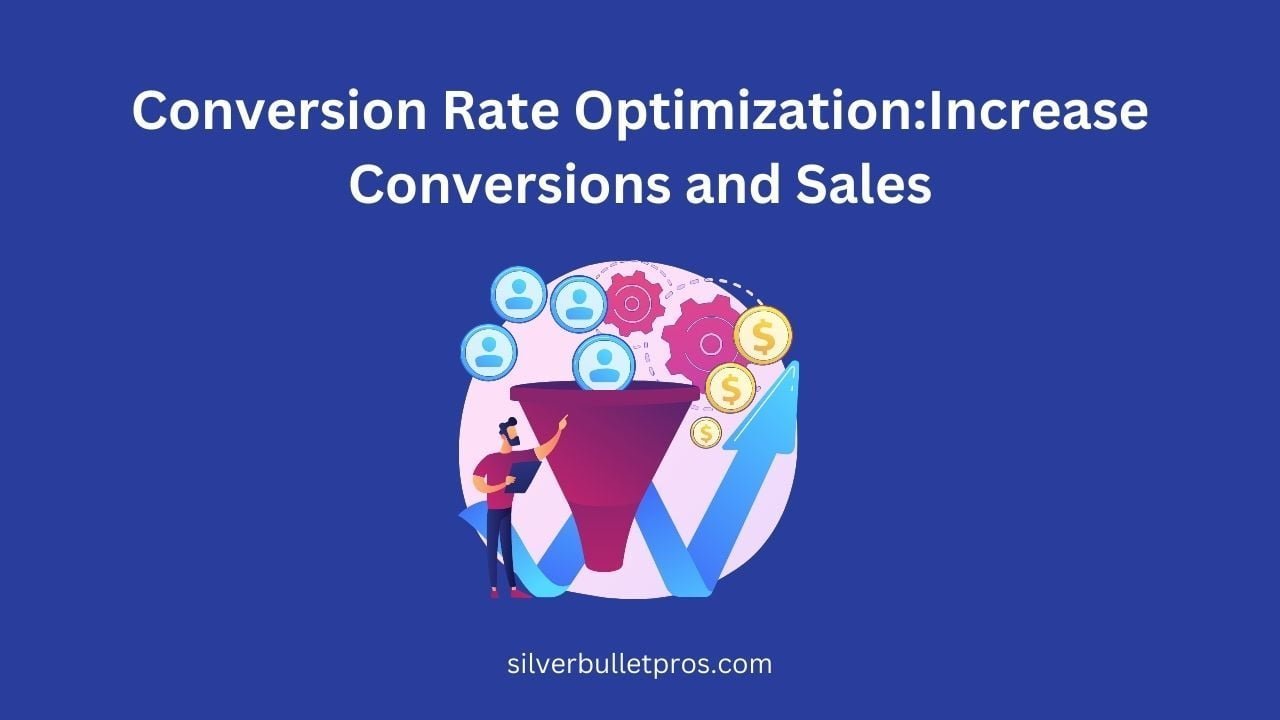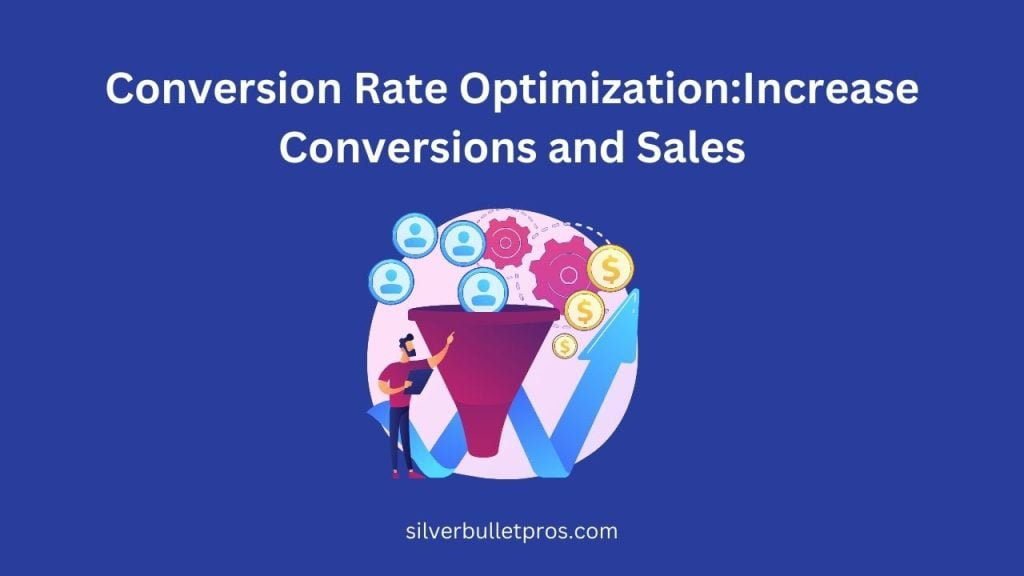

Conversion Rate Optimization (CRO) is the practice of optimizing your website or landing pages to increase the percentage of visitors who take a desired action, such as making a purchase, signing up for a newsletter, or filling out a form. The goal is to maximize conversions while minimizing the cost of acquiring each new customer or lead.
In simpler terms, CRO helps you get more value out of your existing website traffic by making it easier for visitors to complete the actions you want them to take. It involves analyzing user behavior, identifying bottlenecks or friction points, and then testing different variations of design elements, copy, and user flows to see what works best for your target audience.
Why is Conversion Rate Optimization Important?
Conversion Rate Optimization is crucial for several reasons:
- Increased Revenue: Even a small increase in conversion rates can lead to significant revenue growth, especially for businesses with high website traffic volumes. For example, if your website generates 100,000 visitors per month and has a conversion rate of 2%, that's 2,000 conversions. By increasing the conversion rate to just 3%, you'd gain an additional 1,000 conversions without spending more on advertising.
- Better Return on Investment (ROI): CRO allows you to maximize the value of your existing marketing efforts and website traffic, leading to a better return on investment for your advertising and promotional campaigns.
- Improved User Experience: The process of optimizing for conversions often involves enhancing the overall user experience, making it easier for visitors to find what they're looking for, understand your value proposition, and complete the desired actions.
- Data-Driven Decisions: CRO relies heavily on data and analytics, providing valuable insights into customer behavior, preferences, and pain points. This data can inform future marketing, product, and business decisions.
- Competitive Advantage: By continuously optimizing your website and conversion funnels, you can stay ahead of competitors and provide a better overall experience for your target audience.
What are the Benefits of Conversion Rate Optimization?
The primary benefits of Conversion Rate Optimization include:
- Increased Sales and Revenue: By optimizing your website and conversion funnels, you can increase the number of visitors who make a purchase or complete a desired action, leading to higher sales and revenue.
- Improved Customer Acquisition: CRO helps you acquire more customers or leads from your existing website traffic, making your marketing and advertising efforts more cost-effective.
- Better User Experience: The process of optimization often involves enhancing the overall user experience, making it easier for visitors to navigate your website, find what they're looking for, and complete their desired actions.
- Reduced Customer Acquisition Costs: By increasing your conversion rates, you can acquire new customers or leads at a lower cost, as you'll need to drive less traffic to achieve the same number of conversions.
- Data-Driven Insights: CRO provides valuable data and insights into customer behavior, preferences, and pain points, which can inform future marketing, product, and business decisions.
- Competitive Advantage: By continuously optimizing your website and conversion funnels, you can stay ahead of competitors and provide a better overall experience for your target audience.
- Improved Marketing Effectiveness: CRO helps you understand which marketing channels, campaigns, and messaging are most effective at driving conversions, allowing you to optimize your marketing efforts and budget allocation.
Who is Conversion Rate Optimization For?
Conversion Rate Optimization is beneficial for any business or organization that has an online presence and aims to increase conversions, sales, or lead generation. Here are some examples of who can benefit from CRO:
- E-commerce Businesses: Online retailers can use CRO to optimize their product pages, checkout processes, and overall website experience to increase sales and revenue.
- Service-Based Companies: Businesses that offer services, such as consulting, legal, or financial services, can use CRO to optimize their lead generation forms, appointment scheduling processes, and overall website conversions.
- SaaS (Software as a Service) Companies: SaaS businesses can use CRO to optimize their pricing pages, trial signups, and overall user onboarding experience to increase conversions and customer acquisition.
- Lead Generation Businesses: Companies that rely on lead generation, such as real estate, education, or marketing agencies, can use CRO to optimize their landing pages, lead capture forms, and overall conversion funnels.
- Bloggers and Content Creators: While not directly focused on sales, bloggers and content creators can use CRO to optimize their email newsletter signups, affiliate marketing links, and overall user engagement metrics.
- Non-Profit Organizations: Non-profits can use CRO to optimize their donation pages, volunteer signup processes, and overall website experience to increase support and engagement.
Essentially, any business or organization with an online presence and a desire to increase conversions, sales, or user engagement can benefit from implementing Conversion Rate Optimization strategies.
What are the Different Types of Conversion Rates?
There are several different types of conversion rates that businesses and organizations may track, depending on their specific goals and objectives. Here are some common types of conversion rates:
- Sales Conversion Rate: This is the percentage of website visitors who make a purchase or complete a sale. It's a critical metric for e-commerce businesses and online retailers.
- Lead Conversion Rate: This measures the percentage of website visitors who convert into leads by filling out a form, scheduling a consultation, or taking another lead-generating action.
- Email Subscription Conversion Rate: This tracks the percentage of visitors who sign up for your email newsletter or mailing list.
- Content Download Conversion Rate: This measures the percentage of visitors who download a piece of content, such as an ebook, whitepaper, or case study.
- Trial or Freemium Conversion Rate: For businesses that offer a free trial or freemium version of their product or service, this measures the percentage of users who convert to a paid subscription or plan.
- Shopping Cart Abandonment Rate: This is the inverse of a conversion rate, measuring the percentage of visitors who add items to their shopping cart but don't complete the purchase.
- Bounce Rate: While not a direct conversion rate, the bounce rate measures the percentage of visitors who leave your website after viewing only one page, which can be an indicator of potential user experience issues impacting conversions.
- Micro-Conversion Rates: These are smaller, intermediate steps that lead towards a final conversion, such as clicking on a specific button, watching a video, or navigating to a pricing page.
By tracking and optimizing for different types of conversion rates, businesses can gain valuable insights into their customer journey and identify areas for improvement to increase overall conversions and revenue.
How Do You Measure Conversion Rates?
Measuring conversion rates is essential for understanding the effectiveness of your website, marketing campaigns, and overall business performance. Here are some common methods and tools used to measure conversion rates:
- Web Analytics Tools: Platforms like Google Analytics, Adobe Analytics, and Mixpanel provide comprehensive data and reports on website traffic, user behavior, and conversion rates. These tools track various conversion events, such as purchases, form submissions, and click-throughs, and provide detailed conversion rate metrics.
- Conversion Tracking Pixels: These are small snippets of code that can be added to specific pages or elements on your website, allowing you to track conversions and attribute them to specific marketing campaigns or traffic sources.
- Heatmap and Session Recording Tools: Tools like Hotjar, Crazy Egg, and FullStory provide visual representations of user behavior on your website through heatmaps and session recordings. These can help identify potential bottlenecks or friction points that may be impacting conversion rates.
- A/B Testing and Experimentation Platforms: Tools like Optimizely, VWO, and Google Optimize allow you to run A/B tests and experiments on your website, testing different variations of design elements, copy, or user flows to see what impacts conversion rates.
- Customer Relationship Management (CRM) Systems: For businesses that rely on lead generation, CRM systems like Salesforce, HubSpot, and Zoho can track and measure lead conversion rates, from initial website interactions to closed sales.
- E-commerce Platforms: Many e-commerce platforms, such as Shopify, WooCommerce, and Magento, have built-in analytics and reporting features that provide detailed conversion rate data for sales, cart abandonment, and other e-commerce metrics.
- Custom Tracking and Event Tracking: Depending on your specific business needs, you may need to implement custom tracking methods or event tracking codes to accurately measure conversions for unique actions or user interactions.
Regardless of the tools or methods used, it's essential to have a clear understanding of your conversion goals, define what constitutes a conversion for your